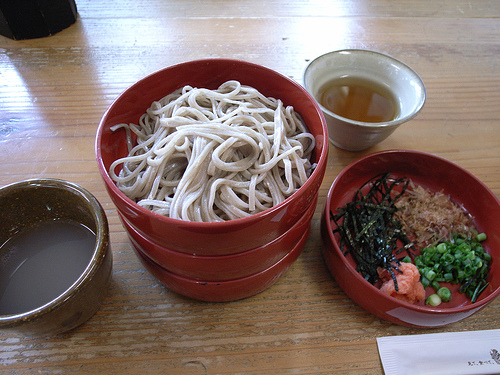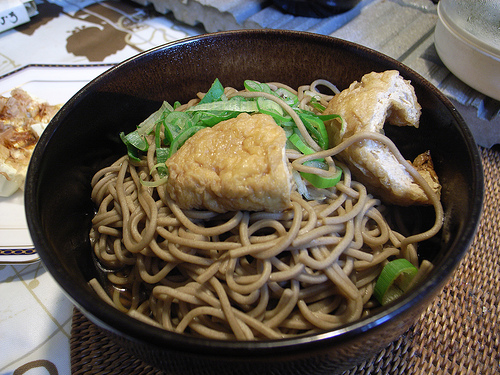Buckwheat Soba Noodles And How Healthy Is It?

Derived from buckwheat, you can easily identify soba from its thin noodles that can both be served with a cold sauce (dipping purposes) or in a tasty soup broth.
There are several types of soba noodles that are made available and turned into your favorite dish. Ju-wari-Soba is the purest kind of soba noodle that is made up of 100% buckwheat flour. It has a dry and rough texture while the noodles are brittle. Other manufacturers will add a little bit of Japanese gelatin called konnyaku to create this thin yet sturdy noodle structure. If you didn't know, there is one type of noodles that is made completly made with konnyaku and it is considered the miracle type noodle because of its health benefits.
Other shops offer ChaSoba which is a green-colored noodle derived by adding green tea powder in the noodle making process. Favored by Japanese female is the UmeSoba which is a noodle flavored with plums giving you a slightly pink color. But regardless of flavor, color or additive in making your noodle, the most preferred soba noodles are the ones that are freshly made called te-uchi.
Satisfying for your Appetite indeed!
Eating buckwheat soba noodles doesn’t just satisfy your gastronomic appetite but also gives you a complete nourishment just by indulging a bowl or serving of this highly nutritious meal.

 by matsuyuki
by matsuyuki
As far calories go, these noodles have the same amounts of calories compared to a spaghetti noodle. But it is low in fat having just over a gram of fat per serving and highly concentrated with fiber. Particularly, the pure Ju-wari-Soba contains 3 grams of fiber per serving which is considered vital in gastronomic cleansing and helps you better manage your weight.
Good Protein
Not just the basic carbohydrate and fiber that you can find in other types of noodle, soba noodles also contain high quality protein. On a 2 ounce serving of dry soba noodle, it can nourish your body with 6 to 8 grams of protein. Since it is made from buckwheat flour, it is rich in lysine and the essential amino acids. But you should take note that these noodles should not be your primary source of protein since buckwheat proteins have a low digestibility and the levels only forms a small percentage of the daily protein requirement.
Some Health Benefits?
These noodles are also full of vitamins and minerals. Iron, calcium, magnesium, zinc and potassium. Also it is especially high in phosphorus which makes up 20% of the daily required intake. It is said that it can be beneficial to pregnant woman as it contains vitamin B which helps process food into energy and folic acid which is important in preventing birth defects.

 by shrk - Soba with dipping sauce (cold)
by shrk - Soba with dipping sauce (cold)
The history of eating soba noodles goes way back during the Edo period where Japanese needs to prepare a highly nutritious meal but with a limited resource. Despite being proven to be a healthy and satisfying meal, it does not mean that you can eat noodles all you want and there is also a drawback in eating too much soba noodles as in any kind of other Japanese style noodles. A bowl or serving contains a generous amount of carbohydrate which in turns creates a glycemic load that impacts your blood sugar level. In short, and as the saying goes: everything should be taken in moderation.





